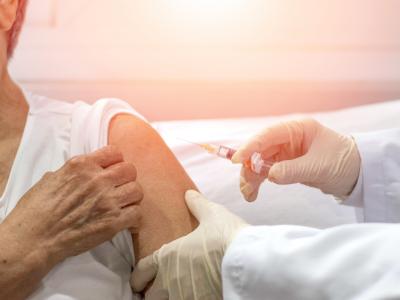Spanish, UK researchers find MCR-1 in Salmonella isolated from mussels
The MCR-1 colistin-resistance gene has been detected in Salmonella strains isolated from mussel samples in Spain, researchers reported yesterday in Eurosurveillance.
Researchers from Spain and the United Kingdom isolated 19 Salmonella strains from 5,907 mussel samples taken from production areas and processing facilities in Galicia from 2012 through 2016, then screened the strains for virulence and antimicrobial resistance (AMR) genes using polymerase chain reaction and whole-genome sequencing. They also performed antimicrobial susceptibility tests. Galicia is the third-largest producer of mussels worldwide and the main supplier of mussels to the European market.
Antimicrobial susceptibility testing revealed that two of the Salmonella strains were resistant to eight and nine antimicrobials, respectively, and genome sequencing detected the MCR-1 gene in strain AMC 90—identified as Salmonella enterica serovar Rissen ST469—along with other resistance genes. The researchers say this is the first time that MCR-1, which is the predominant determinant of transmissible colistin resistance, has been identified in a Salmonella strain from ready-to-eat mussels in the European marine environment.
"The presence of a Salmonella strain carrying the mcr-1 gene in Galicia marine environment constitutes a potential risk to food safety and public health since this gene is usually located in plasmids that can easily be transferred among bacteria in this environment," the authors of the study write. "Implementation of routine pathogens investigations and screening of the presence of resistance genes could contribute to a better understanding of the role of the marine environment and seafood in the transmission of AMR among human pathogens and resident bacteria."
Apr 18 Eurosurveill rapid communication
Study: Italian overprescribing in preschoolers shows little decline
Originally published by CIDRAP News Apr 17
Significant overprescribing of antibacterial to preschool children in Italy's Emilia-Romagna region hasn't improved much over the past decade, despite stewardship recommendations, according to new research based on data from a regional prescription database. The team reported its findings yesterday in the Journal of Antimicrobial Chemotherapy.
According to European surveillance findings, countries vary widely in antibacterial prescribing among children, who often receive them for viral conditions that don't respond to the drugs. Italy is considered sixth highest in antibiotic consumption, and southern European countries have higher prescribing rates compared with Nordic countries.
The analysis of antibacterial prescribing patterns covered children ages 0 to 5 who were seen in outpatient clinics in Emilia-Romagna from 2007 to 2013 and were prescribed at least one systemic antibiotic. Researchers looked at the data by year, sex, and age to gauge periodic prevalence and the annual prescribing rate.
They found that the percentage of children who received at least one prescription per year varied from 68% in 2007 to 59% in 2013, reflecting a slight decrease. The average prevalence of kids who received five or more prescriptions per year was 6.96%. The overall annual prescription rate ranged from 1,621.26 in 2007 to 1,327.27 in 2013.
Broad-spectrum penicillins were the most frequently prescribed antibacterials, making up 63.9% of all prescriptions in the study. Use of narrow-spectrum agents was negligible, at .02%, much lower than countries such as Sweden (27.7%) or Denmark (27.9%). Co-amoxiclav was prescribed more than amoxicillin alone, despite Italian and European guidelines that recommend extended-spectrum penicillins as the first choice for treating the most common childhood bacterial infections.
Macrolides were the third most frequently prescribed antibacterial group, mainly azithromycin and clarithromycin. Cephalosporin use decreased over the study period, but their use was still considerably higher than in Norway or Denmark.
Apr 16 J Antimicrob Chemother abstract
UK survey finds high preventive use of antibiotics in nursing homes
Originally published by CIDRAP News Apr 17
A point-prevalence survey to provide a snapshot of antibiotic use levels in the United Kingdom found high preventive use in long-term care facilities (LTCFs), according to new findings from community pharmacists who conducted the study to identify possible knowledge gaps among caregivers and how pharmacists can provide more support for antimicrobial stewardship efforts. The UK investigators reported their findings yesterday in thesame journal.
For the study, 57 community pharmacists conducted the survey between Nov 13 and Dec 12, 2017, at 644 LTCFs, which included data for 17,909 residents. They found that the mean proportion of residents on the day of their visit was 6.3% for England, 7.6% in Northern Ireland, 8.6% in Wales, and 9.6% in Scotland. Just over a quarter (25.3%) of the antibiotics were prescribed for prophylactic use.
When the researchers asked facilities about antibiotic-related training for staff, they found that it was available at only 6.8% of LTCFs, and only 7.1% of the facilities reported using catheter passports, which are designed to be carried by the patients at all times to help reduce the length of time the catheter is needed and the risk of infection.
Pharmacists intervened during the survey for 9.5% of the antibiotic prescribing events, of which 53.4% were for clinical reasons and 32.2% were for administrative reasons.
The authors concluded that the findings support the role of pharmacy teams in working at LTCFs to provide a greater focus on antimicrobial stewardship, with an eye toward supporting the national goal of reducing inappropriate prescribing 50% by 2021.
Apr 16 J Antimicrob Chemother abstract
Study ties good outcomes to following antibiotic prescribing guidelines
Originally published by CIDRAP News Apr 16
Adhering to antibiotic guidelines was associated with favorable outcomes in terms of mortality and length of hospital stay among patients in Norway, according to a study yesterday in Antimicrobial Resistance & Infection Control.
Norwegian, UK, and Swiss researchers assessed 1,756 patients receiving antibiotics under the care of pulmonary medicine, infectious diseases, and gastroenterology specialties in three university hospitals in western Norway. They analyzed data from 5 months in 2014 and classified patients into receiving care that was either adherent or non-adherent to Norwegian national guidelines.
The team found that 30-day mortality was 52% lower and in-hospital mortality 54% lower in the adherent compared with non-adherent patients. They also discovered a trend toward shorter hospital stays in the adherent group and a 17% higher chance of hospital discharge in the adherent group. Adherence to guidelines, however, was not associated with lower 30-day readmission rates.
The authors conclude, "This study builds on findings in previous studies, indicating that up-to-date, hospital antibiotic guidelines are safe and are associated with favourable clinical outcomes for inpatients. Antibiotic guidelines should be developed and regularly updated to ensure that they always promote best practice in the treatment of infectious diseases in the local context."
Apr 15 Antimicrob Resist Infect Control study
Hotel stay tied to superbug colonization after travel to LMICs
Originally published by CIDRAP News Apr 16
Staying in a hotel is associated with harboring antibiotic-resistant bacteria in travelers to low- and middle-income countries (LMICs), according to data presented yesterday at the European Congress of Clinical Microbiology and Infectious Diseases (ECCMID) in Amsterdam.
German investigators included 230 Germans who traveled outside of Europe in the cohort study. By analyzing stool samples, the scientists found that 53 of the travelers (23%) returned home colonized with extended-spectrum beta-lactamase–producing Enterobacteriaceae (ESBL-PE), with the highest risk tied to traveling to western, eastern, or southern Asia or to northern, middle, or eastern Africa.
Multivariate analysis determined that staying in a hotel in an LMIC raised the risk of ESBL-PE colonization more than fivefold. The risk doubled for travelers who booked a hotel for only part of their stay. The authors say their study is the first to make such a connection.
"Previous studies had already reported this for staying in a private accommodation, but it was unexpected that hotel might also be a risk factor," co-author Lynn Meurs, PhD, from the Robert Koch Institute in Berlin, said in an ECCMID news release. "Colonisation in itself does not lead to any health problems. However, there is a risk of infection with bacteria that patients are colonised with, especially in hospitalised patients."
Apr 15 ECCMID abstract
Apr 15 ECCMID poster
Apr 14 ECCMID news release
European analysis links antimicrobial resistance to climate change
Originally published by CIDRAP News Apr 15
New research presented at the European Congress of Clinical Microbiology and Infectious Diseases (ECCMID) annual meeting suggests an association between AMR and climate change.
Using statistical analysis and computer modeling, a team of German researchers looked at more than 900,000 bacterial isolates collected from 30 European countries over a 6-year period and found significant associations between the warm-season mean temperature and methicillin-resistant Staphylococcus aureus (MRSA), multidrug-resistant Escherichia coli, and carbapenem-resistant Klebsiella pneumoniae.
The researchers also observed that the warm-season mean temperature was a stronger predictor of MRSA variation than outpatient antibiotic use, and that carbapenem-resistant Pseudomonas aeruginosa (CRPA) was significantly associated with a warm-season change in temperature of 0.5°C (0.9°F).
The authors of the study conclude, "These results reveal two aspects: climatic factors significantly contribute to the prediction of AMR in different types of healthcare systems and societies, while climate change might increase AMR transmission, in particular CRPA."
The study builds on research published in 2018 by a team of US scientists that found that an increase in the average minimum temperature across US regions was associated with higher levels of AMR in E coli, K pneumoniae, and S aureus.
Apr 14 ECCMID abstract
Apr 14 ECCMID poster
May 23, 2018, CIDRAP News story "Study finds antibiotic resistance tied to hotter temps"
Study identifies petting zoos as potential source of MDR pathogens
Originally published by CIDRAP News Apr 15
A study presented at ECCMID by Israeli scientists suggests that petting zoos could be a reservoir for multidrug-resistant (MDR) pathogens, potentially posing a threat to people who visit the facilities.
The prospective cross-sectional study was performed in eight petting zoos throughout Israel from December 2016 to May 2018, with researchers collecting fecal and body-surface samples from 228 animals belonging to 42 different species. They identified the bacteria, susceptibility profile, and sequence type (ST) in each sample and used polymerase chain reaction and whole-genome sequencing to identify ESBL and AmpC-carrying Enterobacteriaceae (AmpC-E). They also analyzed questionnaires filled out by zoo owners to determine risk factors for carriage of drug-resistant pathogens.
Analysis of 382 samples revealed that 12% of the animals (28 of 228) carried at least one ESBL/AmpC-producing bacterial strain, with 35 different types of bacteria identified. Seventy-seven percent of the recovered bacterial types were from fecal samples, and 23% were from skin/fur/feathers. Twenty-five percent of the animals carrying ESBL/AmpC-E were co-colonized with more than one strain.
The main bacteria recovered were Enterobacter spp (55%), E coli (31%), and Citrobacter spp (14%). Among the strains identified were the highly virulent enterotoxigenic E coli ST 656, a known cause of traveler's diarrhea, and E coli ST127, which causes urinary tract infections in people.
Analysis of risk factors found that animals treated with antibiotics were more than seven times more likely to carry an MDR pathogen (odds ratio, 7.34).
"Our findings demonstrate that animals in petting zoos can result in shedding and transmission of MDR pathogens that may cause illness for human visitors, even when the animals appear healthy," lead study author Shiri Navon-Venezia, PhD, a microbiologist at Ariel University, said in an ECCMID press release. She and her colleagues suggest petting zoos should implement strict hygiene and infection-control policies to reduce the risk of animal-visitor transmission.
Apr 14 ECCMID abstract
Apr 14 ECCMID poster
Apr 13 ECCMID press release
Study: Bloodstream infection mortality rate varies by organism
Originally published by CIDRAP News Apr 15
In another abstract presented at ECCMID, a retrospective analysis of hospitalized patients from 10 New York healthcare facilities found a wide range of mortality rates associated with bloodstream infections (BSIs) caused by different antibiotic-resistant pathogens.
The researchers sought to evaluate the association between different microorganisms and in-hospital mortality in patients with BSIs by analyzing patients discharged from the 10 facilities over 12 months (January to December 2018). For suspected BSI patients who'd had blood cultures taken, the investigators sent the cultures for molecular analysis to identify the species of microorganism present in the blood. They then grouped the discharged patients by organism type and discharge disposition to assess in-hospital mortality rates by organism.
Overall, 212,257 patients were discharged during the study period, and 4,133 (2%) involved the death of a patient. Of the 6,149 patients who were found to have a BSI caused by one or more microorganism, 744 (12%) died in the hospital. The mortality rate for BSI patients ranged from 8% to 46%, with the highest mortality rates associated with Acinetobacter baumannii (46%), vancomycin-resistant Enterococcus (36%), carbapenem-resistant K pneumoniae (35%), and Candida species (30%). The analysis also found that illicit drug use, pressure ulcers, and acute kidney injury were strongly associated with BSIs, and that coagulase-negative Staphylococcus, typically considered to have low virulence, was associated with a 13% mortality rate.
The authors of the study conclude that molecular identification of organisms with high mortality rates could be crucial in helping clinicians identify the right antibiotic to treat the infection.
Apr 13 ECCMID abstract
Apr 13 ECCMID poster
Study finds drug-resistant pathogens fairly common on patients' hands
Originally published by CIDRAP News Apr 15
A study of patients in two Michigan hospitals reveals that 14% were colonized with a multidrug-resistant organism (MDRO), 10% had an MDRO on their hands, 29% of rooms harbored an MDRO, and 6% of patients acquired a new MDRO on their hands while in the hospital, according to the findings, which appear in Clinical Infectious Diseases.
University of Michigan researchers analyzed data on 399 patients who were enrolled in the study within 24 hours of arrival to their hospital room and had swabs taken from their nostrils, dominant hand, and six high-touch surfaces in their room on admission and weekly until discharge. The authors note that the role of healthcare worker hand contamination in MDRO spread has been well studied, but not the role of patient hand contamination.
The team found that 56 of 399 patients (14.0%) were colonized with MDROs at baseline, 40 of them (10.0%) on their hands. They also discovered that 29% of rooms harbored MDROs, and 14 of 225 patients who had at least two visits (6.2%) had newly acquired MDROs on their hands during their stay. Genetic typing also determined a high correlation between acquiring MRSA on patients' hands and MRSA on room surfaces.
The authors conclude, "Patient hand hygiene protocols should be considered to reduce transmission of pathogens and healthcare-associated infections."
Apr 13 Clin Infect Dis abstract
European, Duke University researchers join efforts to combat resistance
Originally published by CIDRAP News Apr 15
European researchers and a group based at Duke University announced a new joint effort to tackle antibiotic resistance issues, according to a news release from the Duke Clinical Research Institute (DCRI).
The US-based Antibacterial Resistance Leadership Group (ARLG), part of the DCRI, and the University Medical Center (UMC) in Utrecht, the Netherlands, which manages the COMBACTE (Combatting Bacterial Resistance in Europe) consortium, "will work together to solidify a comprehensive global community to combat the threat of antibiotic resistance around the world," according to the release.
The collaboration will include jointly designing and conducting clinical research, holding working meetings at conferences like ECCMID, exchanging data and protocols, and other cooperative efforts. It will also help avoid duplication of efforts.
"We at the ARLG have long admired the work being done by COMBACTE to increase the efficacy of antimicrobial drug development," said Vance Fowler, MD, an investigator at the DCRI and co-principal investigator of the ARLG. "Combining our efforts will allow us to maximize the work we both do to stop the advancement of antibacterial resistance."
"We have already made efforts to expand our reach across Europe, where an increasing number of people suffer from infections caused by antibiotic-resistant bacteria," said Marc Bonten, MD, coordinator of COMBACTE and a professor at UMC Utrecht. "But by collaborating and sharing our progress with the ARLG, we can make a truly global impact beyond this population—an important consideration in a globally connected era in which epidemics travel across oceans quickly."
Apr 13 DCRI news release













